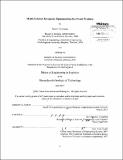| dc.contributor.advisor | Francisco J. Jauffred. | en_US |
| dc.contributor.author | Limvorasak, Saran | en_US |
| dc.contributor.author | Xu, Zhiheng | en_US |
| dc.contributor.other | Massachusetts Institute of Technology. Engineering Systems Division. | en_US |
| dc.date.accessioned | 2013-09-24T19:42:54Z | |
| dc.date.available | 2013-09-24T19:42:54Z | |
| dc.date.copyright | 2013 | en_US |
| dc.date.issued | 2013 | en_US |
| dc.identifier.uri | http://hdl.handle.net/1721.1/81101 | |
| dc.description | Thesis (M. Eng. in Logistics)--Massachusetts Institute of Technology, Engineering Systems Division, 2013. | en_US |
| dc.description | Cataloged from PDF version of thesis. | en_US |
| dc.description | Includes bibliographical references (p. 69). | en_US |
| dc.description.abstract | For fresh produce, the product freshness is a key value to end consumers. Retailers try to maximize product freshness at retail stores while maintaining high product availability. Fresh produce that is close to the end of its life cycle will either be scrapped or be sold at a much lower price. With an increasing demand volatility and complication of supply chain network, obsolescence cost from these spoilages has been increasing recently. Our research focuses on the study of multi-echelon inventory optimization for fresh produce. We investigated the impacts of an additional fulfillment center in a supply chain to justify an improvement in product freshness. We analyzed three relevant factors: transit time, inventory dwell time and safety time, which affect the time products spend in a supply chain from the suppliers to the retail stores. Our objective was to create a predictive model that could determine whether product freshness could be improved when those products are shipped through a supply chain network with an additional fulfillment center. While a fulfillment center increases the total transit time by adding more "touches" of the inventory, it can provide benefits by reducing demand variability through the risk pooling effect. When an fulfillment center aggregates demand from several grocery distribution centers, it pools the demand volatility across various locations, thus reducing the demand volatility and the safety stock. Our model demonstrated that, with a fulfillment center, six product categories (Berries, Watermelons, Cherries, Mixed melons, Stone fruit, and Strawberries) had a decrease in the safety time that is more than the increase in total transit time, resulting in the improved product freshness at retail stores. Further, we defined a term "Enhance Coefficient of Variation (ECV)" to quantify the demand volatility. Finally, we determined a set of minimum ECV ratios in order to make an fulfillment center benefits the product freshness under different replenishment frequencies. Retailers can use this ECV ratio as an indicator to make channeling decisions. | en_US |
| dc.description.statementofresponsibility | by Saran Limvorasak and Zhiheng Xu. | en_US |
| dc.format.extent | 76 p. | en_US |
| dc.language.iso | eng | en_US |
| dc.publisher | Massachusetts Institute of Technology | en_US |
| dc.rights | M.I.T. theses are protected by
copyright. They may be viewed from this source for any purpose, but
reproduction or distribution in any format is prohibited without written
permission. See provided URL for inquiries about permission. | en_US |
| dc.rights.uri | http://dspace.mit.edu/handle/1721.1/7582 | en_US |
| dc.subject | Engineering Systems Division. | en_US |
| dc.title | Multi-echelon inventory optimization for fresh produce | en_US |
| dc.type | Thesis | en_US |
| dc.description.degree | M.Eng.in Logistics | en_US |
| dc.contributor.department | Massachusetts Institute of Technology. Engineering Systems Division | |
| dc.identifier.oclc | 858277942 | en_US |
